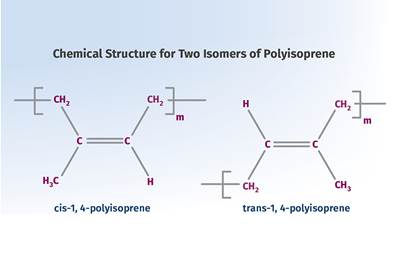Tracing the History of Polymeric Materials--There's More on Celluloid
The invention of Celluloid got the ball rolling for future innovations in materials and processing.
To someone living in the mid-19th century and involved in the world of materials, it must have seemed like a time of revolutionary development. In just one year, 1846, gutta percha was formed into the telegraph wire insulation mentioned in last month’s article; rubber tires were fabricated for use on Queen Victoria’s carriage; Alexander Parkes discovered a technique for vulcanizing rubber at room temperature; and an accidental but notable experiment started the technological development that led to Hyatt’s billiard-ball material.
The experiment was performed by a chemistry professor teaching at the University of Basel in Switzerland, Christian Friedrich Schonbein. He had discovered ozone a few years earlier and had learned that a mixture of nitric and sulfuric acid was an excellent oxidizing agent. While distilling this acidic mixture in his kitchen one day, he knocked over the flask and quickly cleaned up the mess with the nearest available item, a cotton apron. When he attempted to dry the apron by hanging it over a hot stove, it promptly burst into flames and vanished. Nitrated cellulose, also known as guncotton, had been created, and it would lead to a series of inventions that all capitalized on this modification of cellulose.
The discovery of gun cotton set off an 1840s version of an arms race, with patents being filed and countries that wanted to avoid paying licensing fees trying to reverse-engineer the invention. The extreme volatility of the material led to some spectacular accidents all across Europe and Russia in the late 1840s that finally led to bans on additional development and a loss of interest in further experimentation.
However, during that time one of the labs experimenting with cellulose nitrate found that it could be dissolved in a combination of ether and alcohol to form a substance that was named collodion. Once dried, the material became tough and transparent and could serve as a varnish or lacquer, a waterproof coating, or a thin film. It also showed potential as moldable solid. In many respects it exhibited the same capabilities as rubber and gutta percha but offered the possibility of lower cost.
The discovery of gun cotton set off an 1840s version of an arms race.
The same Alexander Parkes who developed the process of cold vulcanization was issued a patent for this moldable material in 1856. Known as Parkesine, it was displayed at the Great Exhibition, a world’s fair that took place in London in 1862. Awarded the bronze medal at this event, the material was on display in the form of many different products that created great expectations. The material was even formed into a billiard ball, anticipating the more well-known development that would come at the end of the decade. Parkes used various vegetable oils as an agent that today we would call a plasticizer to achieve the needed balance of properties.
But the promise of lower cost was never realized. The solvents used to produce collodion for its other uses, in medicine and photography, proved to be too expensive for mass production of a moldable material intended for more competitive markets. In an attempt to make the material competitive, Parkes resorted to using poor quality cotton waste to make cellulose and added such large amounts of the castor oil plasticizer that the material lost its mechanical properties and the products made from it lacked dimensional stability. The product suffered from a high degree of lot-to-lot variability that ultimately doomed it as a commercial venture. However, the invention is considered the first moldable plastic and it paved the way for the improvements that ultimately led to Hyatt’s creation.
It was in this same time period that Michael Phelan, the master billiards player mentioned in last month’s article, offered the $10,000 prize for a billiard ball made of a material that could adequately replace ivory. Phelan was also the inventor of a cushion material for billiards tables that was made of rubber and he owned an interest in a company that made billiard tables. He was acutely aware of the ivory shortage that endangered the growth of an increasingly popular pastime. John Wesley Hyatt, a printer, was attracted by the prospect of claiming the offered prize, and began experimenting with different method of making billiard balls.
The initial versions consisted of combinations of cloth, wood, and paper pieces held together with various glues, varnishes, shellacs, and other adhesives. Hyatt obtained his first patent for an imitation ivory ball in 1865 produced from linen cloth coated with shellac and ivory or bone dust and processed under heat and pressure. This creation was not an adequate substitute for ivory, so Hyatt continued to experiment and obtained a second patent in 1868 for another attempt that consisted of paper and wood pulp combined with shellac and again processed at high heat and pressure.
Hyatt would have been familiar with collodion since it was used extensively in healing wounds and was used in the printing industry to protect line workers from abrasions on their fingertips. In another one of those fortunate accidents, Hyatt one day discovered some collodion that had spilled from its bottle and had formed a hard film. He began coating his latest version of billiard balls by dipping them in collodion. Hyatt encountered the same problems that had plagued Parkes with creating a solid, formable material. So, he continued to work on increasing the viscosity of the material, finally developing a compound that could be formed around a wooden core under high heat and pressure. This generated yet another patent in April 1869 for this improved method of making billiard balls.
Hyatt found the key to making Celluloid into a formable mass by using camphor as a plasticizer.
This invention was ultimately named Celluloid and is known as the material invented by Hyatt to replace ivory, although this name for the material would not be thought of until three years later. Interestingly, the Celluloid billiard balls were never made commercially and were never submitted to Phelan’s company for consideration of the $10,000 award. Hyatt would continue to work on the billiard-ball problem into the early part of the 20th century without achieving the desired goal of a perfect replacement for ivory. That success would come in the first decade of the 1900s from an inventor who was born at the same time that Hyatt was beginning his experiments and whose career had some interesting intersections with Hyatt’s.
Hyatt, by reviewing some of Parkes’s old patents, found the key to making Celluloid into a formable mass by using camphor as a plasticizer. Parkes had employed camphor, but only in conjunction with other solvents. By focusing on camphor and continuing to employ his work with high pressure and heat, Hyatt converted Parkes’s collodion into a versatile material that could have properties similar to those of rubber or gutta percha simply by varying the amount of camphor added to the mixture.
During the time when Hyatt had been working on creating improved billiard balls in the United States, a partner of Alexander Parkes named Daniel Spill had taken on Parkes’s failed commercial venture in England and had also discovered the importance of camphor in making a formable material, which he called Xylonite. The parallel inventions led to the inevitable patent dispute, which was tied up in the courts from 1877 to 1884. It was ultimately decided that both Spill’s and Hyatt’s inventions could be traced back to the work of Parkes, who was deemed to be the original inventor of the material. It was also part of the ruling that all manufacturing of Celluloid products could continue.
In our next column we will follow the fortunes of Celluloid as it found increasing use in a variety of forms that led to the invention of another important plastic processing technique.
ABOUT THE AUTHOR: Mike Sepe is an independent, global materials and processing consultant whose company, Michael P. Sepe, LLC, is based in Sedona, Ariz. He has more than 40 years of experience in the plastics industry and assists clients with material selection, designing for manufacturability, process optimization, troubleshooting, and failure analysis. Contact: (928) 203-0408 • mike@thematerialanalyst.com.
Related Content
Back to Basics on Mold Venting (Part 1)
Here’s what you need to know to improve the quality of your parts and to protect your molds.
Read MoreBack to Basics on Mold Venting (Part 2: Shape, Dimensions, Details)
Here’s how to get the most out of your stationary mold vents.
Read MoreThe Effects of Time on Polymers
Last month we briefly discussed the influence of temperature on the mechanical properties of polymers and reviewed some of the structural considerations that govern these effects.
Read MoreThe Importance of Barrel Heat and Melt Temperature
Barrel temperature may impact melting in the case of very small extruders running very slowly. Otherwise, melting is mainly the result of shear heating of the polymer.
Read MoreRead Next
Tracing the History of Polymeric Materials: Celluloid
In this series we’ll delve into a discerning look back into the history of our industry and how we all got here.
Read MoreSee Recyclers Close the Loop on Trade Show Production Scrap at NPE2024
A collaboration between show organizer PLASTICS, recycler CPR and size reduction experts WEIMA and Conair recovered and recycled all production scrap at NPE2024.
Read MoreLead the Conversation, Change the Conversation
Coverage of single-use plastics can be both misleading and demoralizing. Here are 10 tips for changing the perception of the plastics industry at your company and in your community.
Read More
.jpg;width=70;height=70;mode=crop)





















